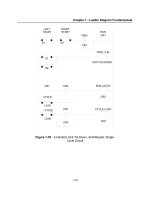rastislav lukac - perceptual digital imaging. methods and applications
Bạn đang xem bản rút gọn của tài liệu. Xem và tải ngay bản đầy đủ của tài liệu tại đây (17.02 MB, 554 trang )
METHODS AND APPLICATIONS
EDITED BY
RASTISLAV LUKAC
METHODS AND APPLICATIONS
Visual perception is a complex process requiring interaction between the recep-
tors in the eye that sense the stimulus and the neural system and the brain that
are responsible for communicating and interpreting the sensed visual informa-
tion. This process involves several physical, neural, and cognitive phenomena
whose understanding is essential to design effective and computationally
efficient imaging solutions. Building on advances in computer vision, image and
video processing, neuroscience, and information engineering, perceptual digital
imaging greatly enhances the capabilities of traditional imaging methods.
Filling a gap in the literature, Perceptual Digital Imaging: Methods and Appli-
cations comprehensively covers the system design, implementation, and
application aspects of this emerging specialized area. It gives readers a strong,
fundamental understanding of theory and methods, providing a foundation on
which solutions for many of the most interesting and challenging imaging
problems can be built.
The book features contributions by renowned experts who present the state of
the art and recent trends in image acquisition, processing, storage, display, and
visual quality evaluation. They detail advances in the field and explore human
visual system-driven approaches across a broad spectrum of applications.
These include image quality and aesthetics assessment, digital camera
imaging, white balancing and color enhancement, thumbnail generation, image
restoration, super-resolution imaging, digital halftoning and dithering, color
feature extraction, semantic multimedia analysis and processing, video shot
characterization, image and video encryption, display quality enhancement,
and more.
This is a valuable resource for readers who want to design and implement more
effective solutions for cutting-edge digital imaging, computer vision, and
multimedia applications. Suitable as a graduate-level textbook or stand-alone
reference for researchers and practitioners, it provides a unique overview of an
important and rapidly developing research field.
Electrical Engineering
K13123K13123K13123
ISBN: 978-1-4398-6856-0
9 781439 868560
9 0 0 0 0
METHODS AND APPLICATIONS
LUKACLUKAC
METHODS AND APPLICATIONS
K13123_FM.indd 1 8/24/12 10:35 AM
Digital Imaging and Computer Vision Series
Series Editor
Rastislav Lukac
Foveon, Inc./Sigma Corporation
San Jose, California, U.S.A.
Computational Photography: Methods and Applications, by Rastislav Lukac
Super-Resolution Imaging, by Peyman Milanfar
Digital Imaging for Cultural Heritage Preservation: Analysis, Restoration, and
Reconstruction of Ancient Artworks, by Filippo Stanco, Sebastiano Battiato, and Giovanni Gallo
Visual Cryptography and Secret Image Sharing, by Stelvio Cimato and Ching-Nung Yang
Image Processing and Analysis with Graphs: Theory and Practice, by Olivier Lézoray
and Leo Grady
Image Restoration: Fundamentals and Advances, by Bahadir Kursat Gunturk and Xin Li
Perceptual Digital Imaging: Methods and Applications, by Rastislav Lukac
K13123_FM.indd 2 8/24/12 10:35 AM
CRC Press is an imprint of the
Taylor & Francis Group, an informa business
Boca Raton London New York
METHODS AND APPLICATIONS
EDITED BY
RASTISLAV LUKAC
K13123_FM.indd 3 8/24/12 10:35 AM
CRC Press
Taylor & Francis Group
6000 Broken Sound Parkway NW, Suite 300
Boca Raton, FL 33487-2742
© 2013 by Taylor & Francis Group, LLC
CRC Press is an imprint of Taylor & Francis Group, an Informa business
No claim to original U.S. Government works
Version Date: 20120822
International Standard Book Number-13: 978-1-4398-6893-5 (eBook - PDF)
This book contains information obtained from authentic and highly regarded sources. Reasonable efforts have been
made to publish reliable data and information, but the author and publisher cannot assume responsibility for the valid-
ity of all materials or the consequences of their use. The authors and publishers have attempted to trace the copyright
holders of all material reproduced in this publication and apologize to copyright holders if permission to publish in this
form has not been obtained. If any copyright material has not been acknowledged please write and let us know so we may
rectify in any future reprint.
Except as permitted under U.S. Copyright Law, no part of this book may be reprinted, reproduced, transmitted, or uti-
lized in any form by any electronic, mechanical, or other means, now known or hereafter invented, including photocopy-
ing, microfilming, and recording, or in any information storage or retrieval system, without written permission from the
publishers.
For permission to photocopy or use material electronically from this work, please access www.copyright.com (http://
www.copyright.com/) or contact the Copyright Clearance Center, Inc. (CCC), 222 Rosewood Drive, Danvers, MA 01923,
978-750-8400. CCC is a not-for-profit organization that provides licenses and registration for a variety of users. For
organizations that have been granted a photocopy license by the CCC, a separate system of payment has been arranged.
Trademark Notice: Product or corporate names may be trademarks or registered trademarks, and are used only for
identification and explanation without intent to infringe.
Visit the Taylor & Francis Web site at
and the CRC Press Web site at
All
our
knowledg
e has its origins in our perceptions.
—Leonardo da Vinci (1452–1519)
This page intentionally left blankThis page intentionally left blank
Dedication
T
o
my
supporters and friends
This page intentionally left blankThis page intentionally left blank
Contents
Pr
eface xi
The
Editor xv
Contrib
utors xvii
1 Characteristics of Human Vision 1
Stefan Winkler
2 An Analysis of Human Visual Perception Based on Real-Time
Constraints of Ecological Vision 37
Haluk
¨
O
˘
gmen
3 Image and Video Quality Assessment: Perception, Psychophysical
Models, and Algorithms 55
Anush K. Moorthy, Kalpana Seshadrinathan, and Alan C. Bovik
4 Visual Aesthetic Quality Assessment of Digital Images 91
Congcong Li and Tsuhan Chen
5 Perceptually Based Image Processing Algorithm Design 123
James E. Adams, Jr., Aaron T. Deever, Efra
´
ın O. Morales, and
Bruce H. Pillman
6 Joint White Balancing and Color Enhancement 167
Rastislav Lukac
7 Perceptual Thumbnail Generation 193
Wei Feng, Liang Wan, Zhouchen Lin, Tien-Tsin Wong, and
Zhi-Qiang Liu
8 Patch-Based Image Processing: From Dictionary Learning to
Structural Clustering 223
Xin Li
9 Perceptually Driven Super-Resolution Techniques 251
Nabil Sadaka and Lina Karam
10 Methods of Dither Array Construction Employing Models of Visual
Perception 287
Daniel L. Lau, Gonzalo R. Arce, and Gonzalo J. Garateguy
ix
x Perceptual
Digital Imaging: Methods and Applications
11 Perceptual Color Descriptors 319
Serkan Kiranyaz, Murat Birinci, and Moncef Gabbouj
12 Concept-Based Multimedia Processing Using Semantic and
Contextual Knowledge 359
Evaggelos Spyrou, Phivos Mylonas, and Stefanos Kollias
13 Perceptually Driven Video Shot Characterization 399
Gaurav Harit and Santanu Chaudhury
14 Perceptual Encryption of Digital Images and Videos 431
Shujun Li
15 Exceeding Physical Limitations: Apparent Display Qualities 469
Piotr Didyk, Karol Myszkowski, Elmar Eisemann, and Tobias Ritschel
Index 503
Preface
V
isual
perception
is a complex process requiring interaction between the receptors in the
eye that sense the stimulus and the neural system and the brain that are responsible for com-
municating and interpreting the sensed visual information. This process involves several
physical, neural, and cognitive phenomena whose understanding is essential to design ef-
fective and computationally efficient imaging solutions. Building on the research advances
in computer vision, image and video processing, neuroscience, and information engineer-
ing, perceptual digital imaging has become an important and rapidly developing research
field. It greatly enhances the capabilities of traditional imaging methods, and numerous
commercial products capitalizing on its principles have already appeared in divergent mar-
ket applications, including emerging digital photography, visual communication, multime-
dia, and digital entertainment applications.
The purpose of this book is to fill the existing gap in the literature and comprehensively
cover the system design, implementation, and application aspects of perceptual digital
imaging. Because of the rapid developments in specialized imaging areas, the book is a
contributed volume where well-known experts are dealing with specific research and appli-
cation problems. It presents the state-of-the-art as well as the most recent trends in image
acquisition, processing, storage, display, and visual quality evaluation. The book serves the
needs of different readers at different levels; it can be used as textbook in support of gradu-
ate courses in computer vision, digital imaging, visual data processing, computer graphics,
and visual communication, or as stand-alone reference for graduate students, researchers,
and practitioners.
This book provides a strong, fundamental understanding of theory and methods, and a
foundation on which solutions for many of today’s most interesting and challenging imag-
ing problems can be built. It details recent advances in the field and explores human visual
system-driven approaches across a broad spectrum of applications, including image quality
and aesthetics assessment, digital camera imaging, white balancing and color enhancement,
thumbnail generation, image restoration, super-resolution imaging, digital halftoning and
dithering, color feature extraction, semantic image analysis and multimedia, video shot
characterization, image and video encryption, display quality enhancement, and more.
The book begins by focusing on human visual perception. The human visual system can
be subdivided into two major components, that is, the eyes, which capture light and convert
it into signals that can be understood by the nervous system, and the visual pathways in
the brain, along which these signals are transmitted and processed. Chapter 1 discusses
characteristics of human vision, focusing on the anatomy and physiology of the above
components as well as a number of phenomena of visual perception that are of particular
relevance to digital imaging.
xi
xii Perceptual
Digital Imaging: Methods and Applications
As motion is ubiquitous in normal viewing conditions, it is essential to analyze the ef-
fects of various sources of movement on the retinotopic representation of the environment.
Chapter 2 deals with an analysis of human visual perception based on real-time constraints
of ecological vision, considering two inter-related problems of motion blur and moving
ghosts. A model of retino-cortical dynamics is described in order to provide a mathemati-
cal framework for dealing with motion blur in human vision.
Chapter 3 addresses important issues of perceptual image and video quality assessment.
Built on the knowledge on perception of images and videos by humans and refined com-
putational models of visual processing, a number of assessment methods capable of pro-
ducing the quality scores can be designed. Although human qualitative opinion represents
the palatability of visual signals, subjective quality assessment is usually time consuming
and impractical. Thus, a more efficient approach is to design the algorithms that can objec-
tively evaluate visual quality by automatically generating the quality scores that correlate
well with subjective opinion.
Chapter 4 focuses on visual aesthetic quality assessment of digital images. Computa-
tional aesthetics is concerned with exploring techniques to predict an emotional response
to a visual stimulus and with developing methods to create and enhance pleasing impres-
sions. Among various modules in the aesthetic algorithm design, such as data collection
and human study, feature extraction, and machine learning, constructing and extracting the
features using the knowledge and experience in visual psychology, photography, and art is
essential to overcome the gap between low-level image properties and high-level human
perception of aesthetics.
The human visual system characteristics are also widely considered in the digital imaging
technology design. As discussed in Chapter 5, digital camera designers largely rely on
perceptually based image processing to ensure that a captured image mimics the scene and
is visually pleasing. Perceptual considerations affect the decisions made by the automatic
camera control algorithms that adjust the exposure, focus, and white balance settings of the
camera. Various camera image processing steps, such as demosaicking, noise reduction,
color rendering, edge enhancement, and compression, are similarly influenced in order to
execute quickly without sacrificing perceptual quality.
Chapter 6 presents the framework that addresses the problem of joint white balancing
and color enhancement. The framework takes advantage of pixel-adaptive processing that
combines the local and global spectral characteristics of the captured visual data in order
to produce the image with the desired color appearance. Various example solutions can
be constructed within this framework by following simple but yet powerful spectral mod-
eling and combinatorial principles. The presented design methodology is efficient, highly
flexible, and leads to visually pleasing color images.
Taking advantage of their small size, thumbnails are commonly used in preview, organi-
zation, and retrieval of digital images. Perceptual thumbnail generation, explored in Chap-
ter 7, aims to provide a faithful impression about the image content and quality. Unlike the
conventional thumbnail, its perceptual counterpart displays both global composition and
important visual features, such as noise and blur, of the original image. This allows the
user to efficiently judge the image quality by viewing the low-resolution thumbnail instead
of inspecting the original full-resolution image.
Preface xiii
Chapter 8
reviews the principles of patch-based image models and explores their possible
scientific connections with human vision models. The evolution from first-generation patch
models, which relate to dictionary construction and learning, to second-generation patch
models, which include structural clustering and sparsity optimization, offers insights on
how locality and convexity have served in mathematical modeling of photographic images.
The potential of patch-based image models is demonstrated in various image processing
applications, such as denoising, compression artifact removal, and inverse halftoning.
Super-resolution imaging aims at producing a high-resolution image or a sequence of
high-resolution images from a set of low-resolution images. The process requires an image
acquisition model that relates a high-resolution image to multiple low-resolution images
and involves solving the resulting inverse problem. Chapter 9 surveys existing relevant
methods, with a focus on efficient perceptually driven super-resolution techniques. Such
techniques utilize various models of the human visual system and can automatically adapt
to local characteristics that are perceptually most relevant, thus producing the desired image
quality and simultaneously reducing the computational complexity of processing.
Digital halftoning refers to the process of converting a continuous-tone image or photo-
graph into a binary pattern of black and white pixels for display on binary devices, such
as ink-jet printers. Similar to dithering used in computer graphics, this process creates the
illusion of depth when outputting an image on a device with a limited palette. Chapter 10
discusses the methods of dither array construction employing models of visual perception,
including the extension of the stochastic dither arrays to nonzero screen angles and the
challenging problem of lenticular printing.
Color features are widely used in content analysis and retrieval. However, most of them
show severe limitations due to their poor connection to the color perception mechanism of
the human visual system and their inability to characterize all the properties of the color
composition in a visual scenery. To overcome these drawbacks, Chapter 11 focuses on
perceptual color descriptors that reflect all major properties of prominent colors. Extracted
global and spatial properties using these refined descriptors can be combined further to
form the final descriptor that is unbiased and robust to non-perceivable color elements in
both spatial and color domains.
Exploiting information in the sense of visual semantics, context, and implicit or explicit
knowledge not only allows for better scene understanding by bridging the semantic and
conceptual gap that exists between humans and computers but also enhances content-based
multimedia analysis and retrieval performance. To address this problem, Chapter 12 deals
with concept-based multimedia processing using semantic and contextual knowledge. Such
high-level concepts can be efficiently detected when an image is represented by a model
vector with the aid of a visual thesaurus and visual context, where the latter can be inter-
preted by utilizing an ontology-based fuzzy representation of knowledge.
Chapter 13 presents perceptually driven video shot characterization, employing an un-
supervised approach to identify meaningful components that influence the semantics of
the scene through their behavioral and perceptual attributes. This is done by using the
perceptual grouping and prominence principles. Namely, the former takes advantage of
an organizational model that encapsulates the grouping criteria based on spatiotemporal
consistency exhibited by emergent clusters of grouping primitives. The latter models the
cognitive saliency of the subjects based on attributes that commonly influence human judg-
xiv Per
ceptual Digital Imaging: Methods and Applications
ment. The video shot is categorized based on the observations that direct visual attention
of a human observer across the visualization space.
With the proliferation of digital imaging devices, protecting sensitive visual information
from unauthorized access and misuse becomes crucial. Given the extensive size of visual
data, full encryption of digital images and videos may not be necessary or economical
in some applications. Chapter 14 discusses perceptual encryption of digital images and
videos that can be implemented by selectively encrypting part of the bitstream representing
the visual data. Of particular interest are attacks on perceptual encryption schemes for
popular image and video formats based on the discrete cosine transform.
Finally, Chapter 15 explores perceptual effects to exceed physical limitations of display
devices. By considering various characteristics of human visual perception, display quali-
ties can be significantly enhanced, for instance, in terms of perceived contrast and disparity,
brightness, motion smoothness, color, and resolution. Similar enhancement could often be
achieved only by improving physical parameters of displays, which might be impossible
without fundamental design changes in the existing display technology and clearly may
lead to overall higher display costs.
As the above overview suggests, this book is a unique up-to-date reference that should
be found useful in the design and implementation of various digital imaging-related tasks.
Moreover, each chapter offers a broad survey of the relevant literature, thus providing a
good basis for further exploration of the presented topics. The book includes numerous ex-
amples and illustrations of perceptual digital imaging results, as well as tables summarizing
the results of quantitative analysis studies. Complementary material for further reading is
available online at .
I would like to thank the contributors for their effort, valuable time, and motivation to
enhance the profession by providing material for a wide audience while still offering their
individual research insights and opinions. I am very grateful for their enthusiastic support,
timely response, and willingness to incorporate suggestions from me to improve the quality
of contributions. Finally, a word of appreciation for CRC Press / Taylor & Francis for giving
me the opportunity to edit a book on perceptual digital imaging. In particular, I would
like to thank Nora Konopka for supporting this project, Jessica Vakili for coordinating the
manuscript preparation, Jim McGovern for handling the final production, Andre Barnett
for proofreading the book, and John Gandour for designing the book cover.
Rastislav Lukac
Foveon, Inc. / Sigma Corp., San Jose, CA, USA
E-mail:
Web: www.colorimageprocessing.com
The
Editor
Rastisla
v
Lukac (www
.colorimageprocessing.com) received
M.S. (Ing.) and Ph.D. degrees in telecommunications from the
Technical University of Kosice, Slovak Republic, in 1998 and
2001, respectively. From February 2001 to August 2002, he
was an assistant professor with the Department of Electronics
and Multimedia Communications at the Technical University of
Kosice. From August 2002 to July 2003, he was a researcher with
the Slovak Image Processing Center in Dobsina, Slovak Republic.
From January 2003 to March 2003, he was a postdoctoral fellow
with the Artificial Intelligence and Information Analysis Labora-
tory, Aristotle University of Thessaloniki, Thessaloniki, Greece. From May 2003 to August
2006, he was a postdoctoral fellow with the Edward S. Rogers Sr. Department of Electri-
cal and Computer Engineering, University of Toronto, Toronto, Ontario, Canada. From
September 2006 to May 2009, he was a senior image processing scientist at Epson Canada
Ltd., Toronto, Ontario, Canada. In June 2009, he was a visiting researcher with the Intel-
ligent Systems Laboratory, University of Amsterdam, Amsterdam, the Netherlands. Since
August 2009, he has been a senior digital imaging scientist at Foveon, Inc. / Sigma Corp.,
San Jose, California, USA. Dr. Lukac is the author of five books and four textbooks, a con-
tributor to twelve books and three textbooks, and he has published more than 200 scholarly
research papers in the areas of digital camera image processing, color image and video pro-
cessing, multimedia security, and microarray image processing. He holds 12 patents and
has authored 25 additional patent-pending inventions in the areas of digital color imaging
and pattern recognition. He has been cited more than 700 times in peer-review journals
covered by the Science Citation Index (SCI).
Dr. Lukac is a senior member of the Institute of Electrical and Electronics Engineers
(IEEE), where he belongs to the Circuits and Systems, Consumer Electronics, and Sig-
nal Processing societies. He is an editor of the books Perceptual Digital Imaging: Meth-
ods and Applications (October 2012), Computational Photography: Methods and Applica-
tions (October 2010), Single-Sensor Imaging: Methods and Applications for Digital Cam-
eras (September 2008), and Color Image Processing: Methods and Applications (October
2006), all published by CRC Press / Taylor & Francis. He is a guest editor of Real-Time
Imaging, Special Issue on Multi-Dimensional Image Processing, Computer Vision and Im-
age Understanding, Special Issue on Color Image Processing, International Journal of
Imaging Systems and Technology, Special Issue on Applied Color Image Processing, and
International Journal of Pattern Recognition and Artificial Intelligence, Special Issue on
Facial Image Processing and Analysis. He is an associate editor for the IEEE Transac-
tions on Circuits and Systems for Video Technology and the Journal of Real-Time Image
xv
xvi Perceptual
Digital Imaging: Methods and Applications
Processing. He is an editorial board member for Encyclopedia of Multimedia (2nd Edi-
tion, Springer, September 2008). He is a Digital Imaging and Computer Vision book series
founder and editor for CRC Press / Taylor & Francis. He serves as a technical reviewer
for various scientific journals, and participates as a member of numerous international
conference committees. He is the recipient of the 2003 North Atlantic Treaty Organiza-
tion / National Sciences and Engineering Research Council of Canada (NATO/NSERC)
Science Award, the Most Cited Paper Award for the Journal of Visual Communication and
Image Representation for the years 2005–2007, the 2010 Best Associate Editor Award of
the IEEE Transactions on Circuits and Systems for Video Technology, and the author of the
#1 article in the ScienceDirect Top 25 Hottest Articles in Signal Processing for April–June
2008.
Contrib
utors
J
ames
E. Adams, Jr. Eastman Kodak Company, Rochester, New York, USA
Gonzalo R. Arce University of Delaware, Newark, Delaware, USA
Murat Birinci Tampere University of Technology, Tampere, Finland
Alan C. Bovik The University of Texas at Austin, Austin, Texas, USA
Santanu Chaudhury Indian Institute of Technology Delhi, New Delhi, India
Tsuhan Chen Cornell University, Ithaca, New York, USA
Aaron T. Deever Eastman Kodak Company, Rochester, New York, USA
Piotr Didyk MPI Informatik, Saarbr
¨
ucken, Germany
Elmar Eisemann Telecom ParisTech (ENS) – CNRS (LTCI), Paris, France
Wei Feng Tianjin University, Tianjin, P. R. China
Moncef Gabbouj Tampere University of Technology, Tampere, Finland
Gonzalo J. Garateguy University of Delaware, Newark, Delaware, USA
Gaurav Harit Indian Institute of Technology Rajasthan, India
Lina Karam Arizona State University, Tempe, Arizona, USA
Serkan Kiranyaz Tampere University of Technology, Tampere, Finland
Stefanos Kollias National Technical University of Athens, Athens, Greece
Daniel L. Lau University of Kentucky, Lexington, Kentucky, USA
Congcong Li Cornell University, Ithaca, New York, USA
Shujun Li University of Surrey, Surrey, UK
Xin Li West Virginia University, Morgantown, West Virginia, USA
Zhouchen Lin Microsoft Research Asia, Beijing, P. R. China
Zhi-Qiang Liu City University of Hong Kong, Hong Kong, P. R. China
Rastislav Lukac Foveon, Inc. / Sigma Corp., San Jose, California, USA
Anush K. Moorthy The University of Texas at Austin, Austin, Texas, USA
xvii
xviii Perceptual
Digital Imaging: Methods and Applications
Efra
´
ın O. Morales Eastman Kodak Company, Rochester, New York, USA
Phivos Mylonas National Technical University of Athens, Athens, Greece
Karol Myszkowski MPI Informatik, Saarbr
¨
ucken, Germany
Haluk
¨
O
˘
gmen University of Houston, Houston, Texas, USA
Bruce H. Pillman Eastman Kodak Company, Rochester, New York, USA
Tobias Ritschel Telecom ParisTech (ENS) – CNRS (LTCI), Paris, France
Nabil Sadaka Arizona State University, Tempe, Arizona, USA
Kalpana Seshadrinathan Intel Corporation, Santa Clara, California, USA
Evaggelos Spyrou National Technical University of Athens, Athens, Greece
Liang Wan Tianjin University, Tianjin, P. R. China
Stefan Winkler Advanced Digital Sciences Center, Singapore
Tien-Tsin Wong The Chinese University of Hong Kong, Hong Kong, P. R. China
1
Char
acteristics
of
Human Vision
Stefan Winkler
1.1 Introduction . . . . . . . . . . . . 2
1.2 Eye . . . . . . . . . . . . 2
1.2.1 Physical Principles . . . . . . . . . . . 2
1.2.2 Optics of the Eye . . . . . . . . . 3
1.2.3 Optical Quality . . . . . . . . . . 4
1.2.4 Eye Movements . . . . . . . . . . 5
1.3 Retina . . . . . . . . . . . 6
1.3.1 Photoreceptors . . . . . . . . . . . 6
1.3.2 Retinal Neurons . . . . . . . . 9
1.4 Visual Pathways . . . . . . . . 11
1.4.1 Lateral Geniculate Nucleus . . . . . . . . . . 11
1.4.2 Visual Cortex . . . . . . . . 12
1.4.3 Multichannel Organization . . . . . . . . 13
1.5 Sensitivity to Light . . . . . . . . . 14
1.5.1 Light Adaptation . . . . . . . . . 14
1.5.2 Contrast Sensitivity . . . . . . . . . 15
1.5.3 Contrast Sensitivity Functions . . . . . . . . 16
1.5.4 Image Contrast . . . . . . . 17
1.5.5 Lightness Perception . . . . . . . 19
1.6 Masking and Adaptation . . . . . . . 20
1.6.1 Contrast Masking . . . . . . . . . 21
1.6.2 Pattern Masking . . . . . . . . 22
1.6.3 Masking Models . . . . . . . . 23
1.6.4 Pattern Adaptation . . . . . . . 24
1.7 Color Perception . . . . . . . . . . . . 24
1.7.1 Color Matching . . . . . . . . . 24
1.7.2 Opponent Colors . . . . . . . . . 26
1.7.3 Color Spaces and Conversions . . . . . . . 27
1.8 Depth Perception . . . . . . . . . . 29
1.9 Conclusion . . . . . . . . . . 30
Acknowledgment . . . . . . . . . 30
References . . . . . . . . . . . . 30
1
2 Perceptual
Digital Imaging: Methods and Applications
1.1
Intr
oduction
V
ision is perhaps the most essential of human senses. A large part of human brain is de-
voted to vision, which explains the enormous complexity of the human visual system. The
human visual system can be subdivided into two major components: the eyes, which cap-
ture light and convert it into signals that can be understood by the nervous system, and the
visual pathways in the brain, along which these signals are transmitted and processed. This
chapter discusses the anatomy and physiology of these components as well as a number of
phenomena of visual perception that are of particular relevance to digital imaging.
The chapter is organized as follows. Section 1.2 presents the optics and mechanics of
the eye. Section 1.3 discusses the properties and the functionality of the receptors and neu-
rons in the retina. Section 1.4 explains the visual pathways in the brain and a number of
components along the way. Section 1.5 reviews human sensitivity to light and various re-
lated mathematical models. Section 1.6 discusses the processes of masking and adaptation.
Section 1.7 describes the representation of color in the visual system and other useful color
spaces. Section 1.8 briefly outlines the basics of depth perception. Section 1.9 provides
conclusions and pointers for further reading.
1.2
Ey
e
1.2.1
Physical Principles
From an optical point of view, the eye is the equivalent of a photographic camera. It
comprises a system of lenses and a variable aperture to focus images on the light-sensitive
retina. This section summarizes the optical principles of image formation.
The optics of the eye rely on the physical principles of refraction. Refraction is the
bending of light rays at the angulated interface of two transparent media with different
refractive indices. The refractive index n of a material is the ratio of the speed of light in
vacuum c
0
to the speed of light in this material c, that is, n = c
0
/c. The degree of refraction
depends on the ratio of the refractive indices of the two media as well as the angle
φ
between the incident
light ray and the interface normal, resulting in n
1
sin
φ
1
= n
2
sin
φ
2
.
This is kno
wn as Snell’s law.
Lenses
e
xploit
refraction to converge or diverge light, depending on their shape. Paral-
lel rays of light are bent outward when passing through a concave lens and inward when
passing through a convex lens. These focusing properties of a convex lens can be used for
image formation. Because of the nature of the projection, the image produced by the lens
is rotated 180
◦
about the optical axis.
Objects at different distances from a convex lens are focused at different distances behind
the lens. In a first approximation, this is described by the Gaussian lens formula:
1
d
s
+
1
d
i
=
1
f
, (1.1)
Characteristics of
Human Vision 3
where d
s
is the distance between the source and the lens, d
i
is the distance between the
image and the lens, and f is the focal length of the lens. An infinitely distant object is
focused at focal length, resulting in d
i
= f . The reciprocal of the focal length is a measure
of the optical power of a lens, that is, how strongly incoming rays are bent. The optical
power is defined as 1m/ f and is specified in diopters.
Most optical imaging systems comprise a variable aperture, which allows them to adapt
to different light levels. Apart from limiting the amount of light entering the system, the
aperture size also influences the depth of field, that is, the range of distances over which
objects will appear in focus on the imaging plane. A small aperture produces images with
a large depth of field and vice versa. Another side effect of an aperture is diffraction, which
is the scattering of light that occurs when the extent of a light wave is limited. The result
is a blurred image. The amount of blurring depends on the dimensions of the aperture in
relation to the wavelength of the light.
Distance-independent specifications are often used in optics. The visual angle
α
=
2arctan(s/2D) measures the extent covered by an image of size s at distance D from the
eye. Likewise, resolution or spatial frequency are measured in cycles per degree (cpd) of
visual angle.
1.2.2 Optics of the Eye
Attempts
to
mak
e general statements about the eye’s optical characteristics are compli-
cated by the fact that there are considerable variations between individuals. Furthermore,
its components undergo continuous changes throughout life. Therefore, the figures given
in the following can only be approximations.
The optical system of the human eye is composed of the cornea, the aqueous humor, the
lens, and the vitreous humor, as illustrated in Figure 1.1. The refractive indices of these
four components are 1.38, 1.33, 1.40, and 1.34, respectively [1]. The total optical power
of the eye is approximately 60 diopters. Most of it is provided by the air-cornea transition,
where the largest difference in refractive indices occurs (the refractive index of air is close
fovea
retina
optic d isc
(blind spot)
aqueous
hum or
choroid
lens
iris
cornea
optic
nerve
sclera
vitreou s
hum or
FIGURE
1.1
The
human
eye (transverse section of the left eye).
4 Perceptual
Digital Imaging: Methods and Applications
to 1). The lens itself provides only a third of the total refractive power due to the optically
similar characteristics of the surrounding elements.
The lens is important because its curvature and thus its optical power can be voluntarily
increased by contracting muscles attached to it. This process is called accommodation.
Accommodation is essential to bringing objects at different distances into focus on the
retina. In young children, the optical power of the lens can extend from 20 to 34 diopters.
However, this accommodation ability decreases gradually with age until it is lost almost
completely, a condition known as presbyopia.
Just before entering the lens, the light passes the pupil, the eye’s aperture. The pupil is the
circular opening inside the iris, a set of muscles that control its size and thus the amount of
light entering the eye depending on the exterior light levels. Incidentally, the pigmentation
of the iris is also responsible for the color of the eyes. The diameter of the pupillary aperture
can be varied between 1.5 and 8 mm, corresponding to a thirtyfold change of the quantity
of light entering the eye. The pupil is thus one of the mechanisms of the human visual
system for light adaptation, which is discussed in Section 1.5.1.
1.2.3 Optical Quality
The physical principles described in Section 1.2.1 pertain to an ideal optical system,
whose resolution is only limited by diffraction. While the parameters of an individual
healthy eye are usually correlated in such a way that the eye can produce a sharp image
of a distant object on the retina, imperfections in the lens system can introduce additional
distortions that affect image quality. In general, the optical quality of the eye deteriorates
with increasing distance from the optical axis. This is not a severe problem, however,
because visual acuity also decreases there, as will be discussed in Section 1.3.
The blurring introduced by the eye’s optics can be measured [2] and quantified by the
point spread function (PSF) or line spread function of the eye, which represent the retinal
images of a point or thin line, respectively; their Fourier transform is the modulation trans-
fer function. A simple approximation of the foveal PSF of the human eye according to
Reference [3] is shown in Figure 1.2 for a pupil diameter of 4 mm. The amount of blurring
depends on the pupil size. Namely, for small pupil diameters up to 3 or 4 mm, the optical
-1
distance [arcmin]
0
1
0
0.4
1.0
relative intensity
-1
0
1
distance [arcmin]
0.2
0.8
0.6
-0.5
0.5
-0.5
0.5
FIGURE
1.2
Point
spread
function of the human eye as a function of visual angle [3].
Characteristics of
Human Vision 5
400
w avelength [nm]
700
0
0.4
1.0
relative sensitivity
20
0
spatial frequency [cp d ]
0.2
0.8
0.6
30
10
500
600
FIGURE
1.3
V
ariation
of the modulation transfer function of a human eye model with wavelength [5].
blurring is close to the diffraction limit; as the pupil diameter increases (for lower ambi-
ent light intensities), the width of the PSF increases as well, because the distortions due to
cornea and lens imperfections become large compared to diffraction effects [4]. The pupil
size also determines the depth of field.
Because the cornea is not perfectly symmetric, the optical properties of the eye are ori-
entation dependent. Therefore, it is impossible to perfectly focus stimuli of all orientations
simultaneously, a condition known as astigmatism. This results in a point spread func-
tion that is not circularly symmetric. Astigmatism can be severe enough to interfere with
perception, in which case it has to be corrected by compensatory glasses.
The properties of the eye’s optics, most important the refractive indices of the optical
elements, also vary with wavelength. This means that it is impossible to focus all wave-
lengths simultaneously, an effect known as chromatic aberration. The point spread function
thus changes with wavelength. Chromatic aberration can be quantified by determining the
modulation transfer function of the human eye for different wavelengths. This is shown in
Figure 1.3 for a human eye model with a pupil diameter of 3 mm and in focus at 580 nm [5].
It is evident that the retinal image contains only poor spatial detail at wavelengths far from
the in-focus wavelength (note the sharp cutoff going down to a few cycles per degree at
short wavelengths). This tendency toward monochromacy becomes even more pronounced
with increasing pupil aperture.
1.2.4 Eye Movements
The eye is attached to the head by three pairs of muscles that provide for rotation around
its three axes. Several different types of eye movements can be distinguished [6]. Fixation
movements are perhaps the most important. The voluntary fixation mechanism allows to
direct the eyes toward an object of interest. This is achieved by means of saccades, high-
speed movements steering the eyes to the new position. Saccades occur at a rate of two
to three per second and are also used to keep scanning the entire scene by fixating on one
highlight after the other. One is unaware of these movements because the visual image
is suppressed during saccades. The involuntary fixation mechanism locks the eyes on the
object of interest once it has been found. It involves so-called micro-saccades that counter
6 Perceptual
Digital Imaging: Methods and Applications
the tremor and slow drift of the eye muscles. The same mechanism also compensates for
head movements or vibrations.
Additionally, the eyes can track an object that is moving across the scene. These so-
called pursuit movements can adapt to object trajectories with great accuracy. Smooth
pursuit works well even for high velocities, but it is impeded by large accelerations and
unpredictable motion.
Understanding what drives the eye movements, or in other words, why people look at
certain areas in an image, has been an intriguing problem in vision research for a long time.
It is important for perceptual imaging applications since visual acuity of the human eye
is not uniform across the entire visual field. In general, visual acuity is highest only in
a relatively small cone around the optical axis (the direction of gaze) and decreases with
distance from the center. This is due to the deterioration of the optical quality of the eye
toward the periphery (see above) as well as the layout of the retina (see Section 1.3).
Experiments presented in Reference [7] demonstrated that the saccadic patterns depend
on the visual scene as well as the cognitive task to be performed. The direction of gaze is not
completely idiosyncratic to individual viewers; however, a significant number of viewers
will focus on the same regions of a scene [8], [9]. These experiments have given rise to var-
ious theories regarding the pattern of eye movements. Salient points attracting attention is
a popular hypothesis [10], which is appealing in passive viewing conditions, such as when
watching television. Salient locations of the image are based on local image characteristics,
such as color, intensity, contrast, orientation, motion, etc. However, because this hypothesis
is purely stimulus driven, it has limited applicability in real life, where semantic content
rather than visual saliency drives eye movements during visual search [11]. There are also
information-theoretic models that attempt to explain the pattern of eye movements [12].
1.3
Retina
The
optics
of the eye project images of the outside world onto the retina, the neural tissue
at the back of the eye. The functional components of the retina are illustrated in Figure 1.4.
Light entering the retina has to traverse several layers of neurons before it reaches the light-
sensitive layer of photoreceptors and is finally absorbed in the pigment layer. The anatomy
and physiology of the photoreceptors and the retinal neurons is discussed in more detail
below.
1.3.1 Photoreceptors
The photoreceptors are specialized neurons that make use of light-sensitive photochem-
icals to convert the incident light energy into signals that can be interpreted by the brain.
There are two different types of photoreceptors, namely, rods and cones. The names are
derived from the physical appearance of their light-sensitive outer segments (Figure 1.4).
Rods are responsible for scotopic vision at low light levels, while cones are responsible for
photopic vision at high light levels.









